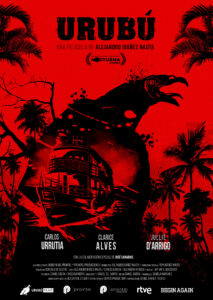URUBU **** Spain 2019 Dir: Alejandro Ibanez. 90 mins
 The best known English title of one of the great 1970s horror films asks rhetorically “Who can kill a child?” Remade in Mexico in 2012 as COME OUT AND PLAY, Narciso Ibanez Serrador’s harrowing parable posits a violent juvenile revolt as the natural response to decades of suffering doled out on children courtesy of their elders. In the five decades since Serrador’s film incorporated real images of child suffering in war zones, our 24/7 news media tells us daily that things have only gotten worse. The director died in 2019, the same year his son made his feature debut with this homage / remake / sequel (depending on your viewpoint). It’s a chilling companion piece updated to a new century in which the world turned its back on inconceivable juvenile suffering in Syria while our leaders repeatedly failed to agree on a satisfactory way forward on the existential threat that will potentially subject our children and their families to an equally cruel fate.
The best known English title of one of the great 1970s horror films asks rhetorically “Who can kill a child?” Remade in Mexico in 2012 as COME OUT AND PLAY, Narciso Ibanez Serrador’s harrowing parable posits a violent juvenile revolt as the natural response to decades of suffering doled out on children courtesy of their elders. In the five decades since Serrador’s film incorporated real images of child suffering in war zones, our 24/7 news media tells us daily that things have only gotten worse. The director died in 2019, the same year his son made his feature debut with this homage / remake / sequel (depending on your viewpoint). It’s a chilling companion piece updated to a new century in which the world turned its back on inconceivable juvenile suffering in Syria while our leaders repeatedly failed to agree on a satisfactory way forward on the existential threat that will potentially subject our children and their families to an equally cruel fate.
Dedicated to Serrador, Alejandro Ibanez’s film opens with ironically beautiful visuals of its ecologically diverse Brazilian locations, accompanied by an old school, sweeping orchestral score by Arturo Diez Boscovich. Birdwatcher / photographer Tomas (Carlos Urrutia) is consumed by his work to the point of marital discord. His alienated wife Eva (Clarice Alves) and oft-ignored, screen-fixated daughter Andrea (Jullie D’Arrigo) trek to the Amazon so that he can nab the first photo out of captivity of the Albino Urubu along the Rio Negro. (“Urubu” = vulture) En route to their secluded location, Andrea sees remarkable sights that she can only relate to YouTube videos while Tomas dismisses the ominous portents they encounter as native superstition.
Through this fracturing family unit, we experience a story of horrifying, perhaps inevitable societal change. An unforgettably brutal scene from Serrador’s film plays on a TV set early on, witnessed (probably as a coal-black ironic joke) by the nonplussed Andrea. Dialogue hints of a natural world rebelling against the scourge of humanity: “The river does strange things…” An ageing labourer talks of his granddaughter getting sick. Andrea starts behaving differently, though it’s hard to quantify as at least one of her parents barely acknowledges her existence. The grown-ups disagree about the best course of action as things become ever more perilous.
With a jarring shock from Tomas’ nightmare providing a preview of horrors to come, Ibanez finds an escalating sense of malevolence in the idyllic location and in the ordinary faces of the smiling, playful groups of kids who have taken to tying up adults as unwitting bait for a piranha feeding frenzy. Tomas gets to ask aloud “Who can kill a child?” to remind us of the film’s heritage but, like the protagonist of the earlier film, finds himself inexorably drawn to the unthinkable. The film saves its most bitter irony for the one moment in which he finally gives his daughter significant attention.
The movie appropriates the dark irony, gruelling images of violence meted out to (and by) children and the circular ending from the 1976 film, but it’s intense, well-acted and powerful in its own right. Like his father, Ibanez hammers home the overarching theme, ending with a barely suppressed cry of rage via a selection of statistics and images conveying the millions of children who continue to be killed or irreparably harmed by war, poverty and violence. The outlook: entirely hopeless.
Review by Steven West

